The ladder of abstractions
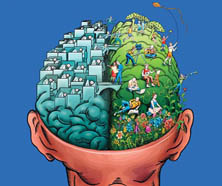 De
abstractieladder is een begrip uit de algemene semantiek De
abstractieladder is een begrip uit de algemene semantiek
 , de eerste
systematische beschrijving van taal gebruik makend van de constatering dat
datgene waar taal over praat, niet de echte wereld is, maar een model van de
wereld gevormd in ons hoofd, zie de illustratie rechts. , de eerste
systematische beschrijving van taal gebruik makend van de constatering dat
datgene waar taal over praat, niet de echte wereld is, maar een model van de
wereld gevormd in ons hoofd, zie de illustratie rechts.
The "ladder of
abstractions" or "abstraction ladder" is a concept taken from the field of
general semantics, founded by Alfred Korzybski
 , that has as its basis
the fact that what we ha , that has as its basis
the fact that what we ha
 ve in our heads is not the real world, but a model
of the world: "The map is not the territory" - see the illustration above
and right. ve in our heads is not the real world, but a model
of the world: "The map is not the territory" - see the illustration above
and right.
Het proces
van het maken van dit model wordt voor het overgrote deel onbewust uitgevoerd,
beginnende met de waarnemingsorganen en gevolgd door een lange reeks hersenonderdelen die
daar aan vastzitten. Een evolutionaire drijfveer achter de ontwikkeling van
veel van de hogere onderdelen is het kunnen onderscheiden van levensvormen
in de leefomgeving in gevaarlijke en ongevaarlijke, oftewel: de indeling in
groepen, gebaseerd op gemeenschappelijke kenmerken. Zo'n groep is geen
object in de direct waarneembare wereld, creërende een onderscheid in het
model van de wereld in het hoofd van direct waarneembare object, rechts in
de illustratie, en
de daarvan geabstraheerde groepen, links.
The process of making this
model is executed mostly conconciously, by our sensory organs and the large
namuber of neurological structures attached to them. The evolutioal drieve
behind developing this system is that it is advatageous to be able to
disntinguish between dangerous lif forms and friend;ly ones, i.e. to be able
to collect these in separate and disngyuishale groups. These groups arn't
objets existitng in the real wotrld, thus creating a discitncion
between objects in the model that are and those thar aren't part of the real
world., the "abstractions", the most obvious feature of the first illustion,
Deze eigenschap is al
aanwezig in vele diersoorten, zeker vanaf het niveau dat ze elkaar kunnen
waarschuwen voor gevaar als roofdieren. Bij de mens is dat het hoogst
ontwikkeld, in de vorm bekend als "taal".
This capacity is present in
many species of animals, amongst whom certainly tose that are able to warn
xxxx for danger. It is developed the farthest in humankind, in a form known
as "speech". Which has led to more kinds of abstractions, known as "higher
abstractions".
De abstractieladder is de
systematische uitwerking van relaties tussen groepen van allerlei soorten,
waaronder dus degene bekend als "abstracties", begrippen zonder directe band
met de werkelijkheid. Dit is dus een weerslag van neurologische
ontwikkelingen, maar in de algemene semantiek is het gedaan direct vanuit
het uitganspunt van taal, en de betekenis van woorden. Beginnende met een
indeling van de verschillende soort van woorden.
The abstraction ladder
is an attempt to a systematic approach to the relations between the kinds of
groups of all sorts, including the "abstractions"., when these are
exptressed in words. This is the analagon in speech or language of the
neurological processes taking place ine the brain when distinguishing
between species. This description starts by analyzing the different kinds of
words.
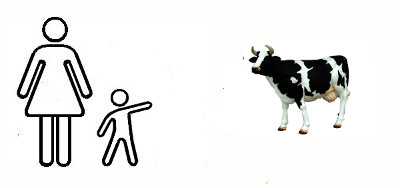 De
allereerste soort woorden en een goede kandidaat om de oorsprong te zijn
van de ontwikkeling van taal zijn de aanwijswoorden. Ze zijn noodzakelijk om
een verbinding te leggen tussen een klankuitstoot en een object. Ook
"moderne" kinderen leren taal op die manier. Hier in het voorbeeld: Mama: "Daar is Bessie!" Door volwassenen die alles al geleerd hebben, herkend als
een "koe". De
allereerste soort woorden en een goede kandidaat om de oorsprong te zijn
van de ontwikkeling van taal zijn de aanwijswoorden. Ze zijn noodzakelijk om
een verbinding te leggen tussen een klankuitstoot en een object. Ook
"moderne" kinderen leren taal op die manier. Hier in het voorbeeld: Mama: "Daar is Bessie!" Door volwassenen die alles al geleerd hebben, herkend als
een "koe".
The first kind of word and also a prime candidate to be the
origin of the development of speech are here called "object words" - words
that denotes things that you can point to in the real world. They are an
neceesity to be able to make a conntection between a specific utterance of
sounds coming out of your mouth and the objects in de the real world. Even
"modern" kids start to learn language this way. For the example in the
illustration: "Mama, there is Bessie!".
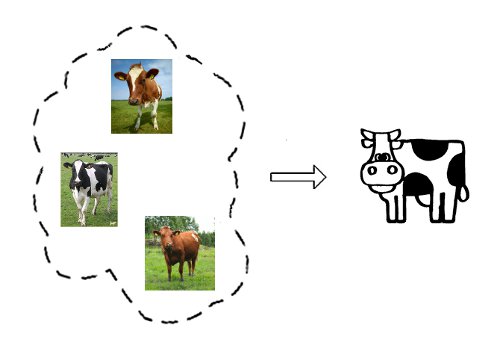 De
tweede soort woorden is die van de eerste en natuurlijk ontstaande abstracties: alle
beesten die op "Bessie" lijken - "Klara", "Johanna" enzovoort, waarbij "Klara" en "Johanna"
de
aanwijswoorden zijn voor twee bepaalde andere koeien op de boerderij. Het woord
"koeien" heeft de gezamenlijke eigenschappen van alle koeien op de boerderij, maar
een groot aantal individuele eigenschappen van Bessie enzovoort gaan daarbij
verloren; samengevat als: het verzamelwoord "koeien" is abstracter dan het
aanwijswoord "Bessie". De
tweede soort woorden is die van de eerste en natuurlijk ontstaande abstracties: alle
beesten die op "Bessie" lijken - "Klara", "Johanna" enzovoort, waarbij "Klara" en "Johanna"
de
aanwijswoorden zijn voor twee bepaalde andere koeien op de boerderij. Het woord
"koeien" heeft de gezamenlijke eigenschappen van alle koeien op de boerderij, maar
een groot aantal individuele eigenschappen van Bessie enzovoort gaan daarbij
verloren; samengevat als: het verzamelwoord "koeien" is abstracter dan het
aanwijswoord "Bessie".
The second kind of words are those of the
natural collections of these objects, in this case: all of the objects that
look like "Bessie": "Clare", "Mathilda" etc.., where "Clare" and "Mathilda"
are the "object words" connected to two other "cows" that occupy the meadow
of the farm, where "cows" is the word for the collection of traits that
these three (and probably more) have in common. Whereby also a lot of the
individual traits of Bessie etc. have been lost. The fact that there are a
lot of traits are lost while retaining certain others, is denotad by another
word for this collection: that of "abstraction".
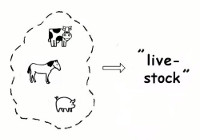 De
boerderij van Klaas heeft naast koeien ook paarden en varkens. Koeien en paarden
en varkens zijn heel verschillend, maar voor boer Klaas toch ook weer gelijk in een aantal
zaken: zo hebben zowel koeien als paarden voer nodig, produceren ze mest,
enzovoort. Die gemeenschappelijke eigenschappen worden samengevat in het woord
"vee", in het Engels livestock oftewel: "levende have".
Merk op dat er voor "vee" geen afbeelding is te maken. Kennelijk is het zo
dat hoewel beide termen abstracties zijn, "vee" een andere relatie tot de
werkelijkheid heeft dan "koe". Hiervoor is dus de term "hogere abstracties". De
boerderij van Klaas heeft naast koeien ook paarden en varkens. Koeien en paarden
en varkens zijn heel verschillend, maar voor boer Klaas toch ook weer gelijk in een aantal
zaken: zo hebben zowel koeien als paarden voer nodig, produceren ze mest,
enzovoort. Die gemeenschappelijke eigenschappen worden samengevat in het woord
"vee", in het Engels livestock oftewel: "levende have".
Merk op dat er voor "vee" geen afbeelding is te maken. Kennelijk is het zo
dat hoewel beide termen abstracties zijn, "vee" een andere relatie tot de
werkelijkheid heeft dan "koe". Hiervoor is dus de term "hogere abstracties".
Tom's farm is also the residence of other objects besides "cows".
"Horses" and "pigs" are quite different from "cows", but to farmer Tom they
also have some similarities: they all require feed, they ar produce manure,
etc. These common traits are abbreviated into the word "live stock", Which
cna be seen as a "collection of collections". Note there is in general no
natural way to associate a symbol with these "collections of collections".
Thereby one can distinguish them from the first kind of collections, which
were equivalently named "abstrations", as "higher order abstactions".
Als deel van "vee" verliest koe "Klara" weer een groot deel van haar
eigenschappen: het melk geven (althans: als producent), en bijvoorbeeld ook haar
kleur. Koeien zijn zwart-wit, paarden bruin en varkens roze, dus je kan niet
spreken van de "kleur" van "vee".
As part of the collection of "live stock", Bessie loses even more of her
specific traits: giving milk (at least: as a mass-producer), and also for
example her color: cows are frequently black-and-white, horses are brown and
pigs are pink. So note: one cannot have "the color of livestock".
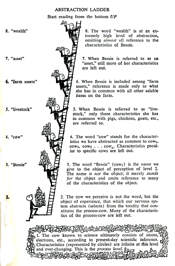 Het
is duidelijk dat hiermee het hek min of meer van de dam is. Zo kunnen we de
"levende have" van boer Klaas samenvoegen met zijn "dode have", dat laatste
zijn tractor, ploeg, maaimachine enzovoort, tot "inboedel". En "inboedel"
kan weer worden samengenomen met landerijen en huis tot "bezit", "waarbij
het laatste weer vertaalbaar is in "geld" of "rijkdom", rechts in de versie
van S.I. Hayakawa Het
is duidelijk dat hiermee het hek min of meer van de dam is. Zo kunnen we de
"levende have" van boer Klaas samenvoegen met zijn "dode have", dat laatste
zijn tractor, ploeg, maaimachine enzovoort, tot "inboedel". En "inboedel"
kan weer worden samengenomen met landerijen en huis tot "bezit", "waarbij
het laatste weer vertaalbaar is in "geld" of "rijkdom", rechts in de versie
van S.I. Hayakawa
 , de naamgever van het begrip in deze vorm (klik erop voor een vergroting).
, de naamgever van het begrip in deze vorm (klik erop voor een vergroting).
It should be clear that this last addition to the kinds of words opens the
floodgates. For example: one can combine farmer Tom's "live stock" with all
of the machinery he needs for his work into "farm assets". Possible further
steps are "property", and "wealth" or "capital". Those are the steps used by
the originator of this version of "the ladder of abstractions", S.I.
Hayakawa
 , in his book Language in Thought and Action , in his book Language in Thought and Action
 (click on the illustration for a larger version).
(click on the illustration for a larger version).
Maar ook andere indelingen zijn mogelijk: het bezit van boer Klaas maakt deel
uit van het "agrarische sector" van het dorp, het dorp maakt deel uit van de
streek, de streek van het land enzovoort. Het hek is dus niet alleen van de dam
wat betreft de hoogte van de abstracties die men kan maken, maar ook wat betreft
de breedte.
But other classifications are equally possible: farmer Tom's
property is part of the agricultural assets of the villagee, the village is
an element of the region, the regions make up the country, etc. So not
only are the floodgates opened as far as the depth of the abstractions
is concerned, this also applies to their width.
In principe houdt het kunnen maken van verzamelingen nergens op: het heelal is
groot genoeg. Maar het is redelijk duidelijk dat de nuttigheidswaarde van
verzamelingen wel redelijk snel afneemt - abstracter dan "geld" lijkt weinig
nuttig, en ook qua breedte zijn er beperkingen: koeien samen nemen met
schilmesjes kán, maar lijkt weinig zinvol.
In fact, the possibilities of making abstractions never end - the universe
is probaly big enough for all of them. But this limitation never comes into
sight, because where it is possible have have gazillions of them, most of
them have little or no pratical use: one can take cows together with peeling
knives, but it hardly seems to make any sense (of course: creative types
will have a go after such a statement).
This is the model as
developed in the field of general semantics. It is now going to be extended
with some new feautes. First of all the abstraction ladder is generalized,
and this genralization leads the way to what was also an ultimate goal of
Korzybski: the connection with neurology and psychology.
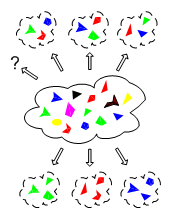 Waar
het om draait, is dat iedere stap op de abstractieladder twee dingen doet - in de stap van
koeien naar "vee" omvat je meer soorten dingen, en tegelijkertijd verlies je
specifieke eigenschappen van die dingen. In de meer schematische
abstractieladder van hiernaast zie je in de wolk van de "werkelijkheid"
figuurtjes met verschillende eigenschappen als het aantal hoeken en de kleur -
in de verzamelingen eronder verdwijnt het aantal hoeken als kenmerk, en in die
erboven de kleur. En in volgende stappen die je kan maken als je op het diagram
klikt, gaat nog meer verloren, tot je al snel uitkomt op het meest abstracte
mathematische figuur: de (eigenschaploze) punt (klik erop voor een interactieve
vergroting). Waar
het om draait, is dat iedere stap op de abstractieladder twee dingen doet - in de stap van
koeien naar "vee" omvat je meer soorten dingen, en tegelijkertijd verlies je
specifieke eigenschappen van die dingen. In de meer schematische
abstractieladder van hiernaast zie je in de wolk van de "werkelijkheid"
figuurtjes met verschillende eigenschappen als het aantal hoeken en de kleur -
in de verzamelingen eronder verdwijnt het aantal hoeken als kenmerk, en in die
erboven de kleur. En in volgende stappen die je kan maken als je op het diagram
klikt, gaat nog meer verloren, tot je al snel uitkomt op het meest abstracte
mathematische figuur: de (eigenschaploze) punt (klik erop voor een interactieve
vergroting).
The pivotal point in the abstraction ladder is that every
step on it does two things: like the one taken from cows to farm animals, it
enlarges the scope of the objects, and at the same time it takes away
specific traits of the objects. To furthers illustrate this point, an
interactive model has been made, click on the illustration (right) to start
this, using the simplest objects: triangles, squarets etc. Which immediately
introduces an aspect that is not easy to incorporate into natural models:
even the first kind of collections are not an obvious choice. And it also
illustrates that this choice matters: taking color as an ordering criterium,
ends the process immediately. So besides that the making collections or
abstractions is a crucial step, the choice of which kind of collections
i.e.the choice of criteria is equally vital. In life forms that adept to
changing environments, like humankind, these criteria are not build-in but
are learned. It should be clear that the higher the abstractions that can be
build, the more able they wil be to see higher patterns in the environment
and thereby to predict future events.
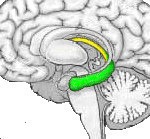 Dit
is het model zoals ontwikkeld binnen de algemene semantiek, als beschrijving
van wat er binnen het verschijnsel "taal" gebeurt. Kennis ontwikkeld in
2014 en later Dit
is het model zoals ontwikkeld binnen de algemene semantiek, als beschrijving
van wat er binnen het verschijnsel "taal" gebeurt. Kennis ontwikkeld in
2014 en later
 laat zien dat dit letterlijk zo werkt binnen het brein, in
het onderdeel genaamd de hippocampus laat zien dat dit letterlijk zo werkt binnen het brein, in
het onderdeel genaamd de hippocampus
 , liggende aan de rand van de aan de buitenkant liggende cortex en de
binnenliggende emotie-organen. In de hippocampus worden zowel beelden
als taal herkend aan de hand van abstracte concepten in de waarneming en in
het geheugen. In de cortex werd er "gedacht" en "geredeneerd" met de
concepten. De andere helft van het brein, de speelse grazige weide, heeft
ook een eigen plaats in een aantal onderdelen in het brein (de basale
ganglia), zie hier
, liggende aan de rand van de aan de buitenkant liggende cortex en de
binnenliggende emotie-organen. In de hippocampus worden zowel beelden
als taal herkend aan de hand van abstracte concepten in de waarneming en in
het geheugen. In de cortex werd er "gedacht" en "geredeneerd" met de
concepten. De andere helft van het brein, de speelse grazige weide, heeft
ook een eigen plaats in een aantal onderdelen in het brein (de basale
ganglia), zie hier
 .
.
So having concluded that at least in human kind, but probaly also in
more primitive versions in earlier live forms, the process of building
abstractions is something that has to be learned, at least in some respects,
the next question is: where and how? The first question had already been
answered, in recent research
 , the year of wrting being 2016 and the publication year of the
research being 2014. The location where the abstractions are made is the
hippocampus, a structure lying at the end of the "emotion organs" or limbic
system in the centre of the brain and at the beginning of the (neo-)cortex,
the outside of the brain and its major portion. The (neo-)cortex is
well-known as the location where the "thinking" and "reasoning" using
abstractions takes place. The other half of "the brain" as in the first
illustration, the "happy green fields" of the right hemisphere, also have
their own place in a number of structures: the basal ganglia and
surroundings - the "emotion organs".
, the year of wrting being 2016 and the publication year of the
research being 2014. The location where the abstractions are made is the
hippocampus, a structure lying at the end of the "emotion organs" or limbic
system in the centre of the brain and at the beginning of the (neo-)cortex,
the outside of the brain and its major portion. The (neo-)cortex is
well-known as the location where the "thinking" and "reasoning" using
abstractions takes place. The other half of "the brain" as in the first
illustration, the "happy green fields" of the right hemisphere, also have
their own place in a number of structures: the basal ganglia and
surroundings - the "emotion organs".
Dit was de "inleiding". Want nu pas is het punt bereikt waarop er
met dit lichaam van kennis iets gedaan kan worden. Met voor de zekerheid
toch nog een "voorzet": het zal duidelijk zijn dat het gebruik van hogere
concepten, of hogere abstracties, mogelijkheden geeft om hogere patronen te
zien, en eerder tot herkenning te komen, dus voordelen geeft. Reden waarom
het gebruik van hogere concepten in het brein gepaard gaat met stimulerende
signalen - voor degenen bekend met neurologie dan wel duidelijk hoe: die
gaan gepaard met de afgifte van dopamine.
So where the hippocampus is the
location where the impressions of the sensory organs are analyzed into
concepts, using them for "recognition" (note: to re-cognize: "to make sense
of again"), this probably is also the place where the abstractions are
learned. Thus: where, say by starting with "trial and error", effective
abstractions are enhanced and made permanent and ineffective ones are
discouraged and discarded. And anybody knowing anything about neurology
knows how things are stimulated in the brain: by the use of dopamine.
 De
essentiële toepassing van dit alles is deze: net als ieder proces in de
hersenen dat leidt tot het vrijmaken van dopamine, is ook dit proces
onderhevig aan de potentie van verslaving: hoe abstracter en algemener het
gemaakte begrip, des te meer kans op een "treffer", des te meer het
abstracte begrip ingeslepen wordt in de hippocampus, des te meer kans op een
treffer, enzovoort. Het boek van Hayakawa De
essentiële toepassing van dit alles is deze: net als ieder proces in de
hersenen dat leidt tot het vrijmaken van dopamine, is ook dit proces
onderhevig aan de potentie van verslaving: hoe abstracter en algemener het
gemaakte begrip, des te meer kans op een "treffer", des te meer het
abstracte begrip ingeslepen wordt in de hippocampus, des te meer kans op een
treffer, enzovoort. Het boek van Hayakawa
 waarin hij zijn versie van de abstractieladder introduceert, is voor een
groot deel gewijd aan fouten in het omgaan met abstracties, en een groot
deel van die fouten wordt ingegeven door verslaafheid, van licht tot zeer
ernstig, aan de dopamine vrijgemaakt bij het gebruik van abstracties. Fouten
met kleurrijke beschrijvende namen als "dead level abstracting"
waarin hij zijn versie van de abstractieladder introduceert, is voor een
groot deel gewijd aan fouten in het omgaan met abstracties, en een groot
deel van die fouten wordt ingegeven door verslaafheid, van licht tot zeer
ernstig, aan de dopamine vrijgemaakt bij het gebruik van abstracties. Fouten
met kleurrijke beschrijvende namen als "dead level abstracting"
 en "chasing each other in verbal circles"
en "chasing each other in verbal circles"
 .
.
Thereby almost coming to the essence of these new additions tot the
ladder of abstractions: any process in the brain that involves dopamine is
subject to the potential of addiction. In this case: the higher a concpet,
the more likely it is to lead to a hit, the more it is stimulated by the
feeering op dopamnine, the more prominent the concept becoms in the
hippocampus, the more likely it leads to a hit, etc. Together: higher
concepts are ponentially addictive. A large part of the book by Hayakawa is
devoted to describing amelioratingg errors made both verbally and in
the actual world, that are the consequence of faulty use op abstractions, in
most cases due to the addictiveness of higher abstractions. Errors having
dresctiptive nad colorfull names like "dead level abstracting"
 and "chasing each other in verbal circles"
and "chasing each other in verbal circles"
 .
.
Die fraaie en al zo treffend gebleken eerste illustratie van wat er zoal
omgaat in het hoofd kan dus aangepast worden tot dit:
With all this extra
knowledge gained, it is possible to further enhance the first illustration
that already showd so inventively the partitioning of the basic
functionalities of the brain to this:
Als eerste, om de waarde aan te geven: de wereld van de abstracties is getild een stukje boven die
van de werkelijkheid, en verder omhoog gaand (zo goed mogelijk).
As a
fist step, to denaote the extra preductave value of using abstactions, the
left hemishpere has been lifted lsightly, going further upwards to the left
(as good a spossible)
En
de valkuilen zijn uitgebeeld als (dat zijn er meer, want er moet wat van
geleerd worden):
- het aantal hokjes is min of meer overeenkomstig
gemaakt met het aantal concepten, en neemt dus af verder komende van de
werkelijkheid.
-
de "personen" die de concepten bedienen, hebben nog steeds hun hoofd afgewend van de
werkelijkheid (deels uit hoofde van tijdsbesparing).
- de weg naar de
abstracties is een stuk drukker dan die terug naar de werkelijkheid.
And
the pitfalls are displayed as follows (these are more numerous beacause
somethingg has to be learned from of all of this):
- the number of
cubicles is made to corrrespond (approximatley) tot the number of conpets,
goning to the left and going away from reality.
- the "persons"
controlling the concpet cubilces have theur heads truned away form reality
(as before -partly due to lack of time to make this adeption).
-
the number of "persons" turning away from reality and towards abstractions
in made considerably larger than those going from abstrations back towards
reality.
 De belangrijkste les uit dit alles is natuurlijk deze: als redenaties of
argumenten ergens toe moeten leiden, zorg er dan altijd voor dat de uitkomst
ervan iets zegt over de werkelijkheid. De buitenwereld. Die stap doorbreekt de cirkels
leidende tot verslavingen. De belangrijkste les uit dit alles is natuurlijk deze: als redenaties of
argumenten ergens toe moeten leiden, zorg er dan altijd voor dat de uitkomst
ervan iets zegt over de werkelijkheid. De buitenwereld. Die stap doorbreekt de cirkels
leidende tot verslavingen.
The crucial lesson to be learned from this all
is of course this: if reasonings or arguments are intended to lead tot
something having sens,e then alwyas tkee care that the oucome of them says
somehting about reality. The world outside of the model in your head. This
is the step that breaks the inward spiral that leads to addictions
Dat klink heel simpel, maar het aantal
gevallen dat er aan voldaan is, buiten de wereld van de natuurwetenschappen
 , ligt op geen ander gebied van de maatschappij boven de 20 procent, en
zodra er ideologie om de hoek komt kijken
, ligt op geen ander gebied van de maatschappij boven de 20 procent, en
zodra er ideologie om de hoek komt kijken
 ,
of retorische trucs
,
of retorische trucs
 of andere vormen van taalvervalsing worden gebruikt, nadert
dat percentage razendsnel naar nul
of andere vormen van taalvervalsing worden gebruikt, nadert
dat percentage razendsnel naar nul
 . .
This sounds really simple, but the number of cases that abide by it
relative to those that don't, is extremely low, outside of the world of the
natural sciences where this step is encoded (
 , see the pictures). As an overall guess for all fields outside science, the
maximum number is probably lower than twenty, where in all cases where
ideology is involved, and all cases where retorical fallacies and similar
falsfications of language are used, the percentage tends towards zero with
almost the speed of light.
, see the pictures). As an overall guess for all fields outside science, the
maximum number is probably lower than twenty, where in all cases where
ideology is involved, and all cases where retorical fallacies and similar
falsfications of language are used, the percentage tends towards zero with
almost the speed of light.
Naar Alg. semantiek, inleiding
 , of site home
, of site home
 . .
|